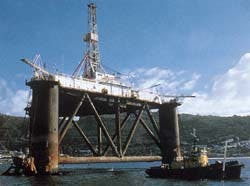Operator Soekor and license partner Energy Africa expect to begin production from Oribi offshore field in April. Initially, two producers and a water injection well will be tied back to Orca, a converted semisubmersible rig. Once the field is on stream, Soekor plans to tie in nearby oil finds. (Photo courtesy of Energy Africa.)Soekor (Pty.) Ltd. is nearing completion of South Africa's first oil field development, and expects to begin production next month with a converted semisubmersible rig.
Oribi field was originally designated E-BT, and was discovered in 1990 in the Bredasdorp basin, 140 km southwest of Mossel Bay.
The license is owned 80% by operator Soekor and 20% by Energy Africa Bredasdorp (Pty.) Ltd.
Soekor estimates Oribi field reserves at 20 million bbl of 42° gravity oil, and it expects to achieve initial production of 20,000 b/d from two wells. The main reservoir is at a depth of 7,680 ft.
The operator also plans to use high pressure seawater injection of as much as 30,000 b/d via an additional predrilled well.
Oribi development is expected to cost $75 million. The semisubmersible rig Orca, previously known as Sedco I, will produce oil into a dedicated shuttle tanker for export.
Soekor reckons the field life of Oribi will be around 4 years, but the company intends to extend this to 7-10 years by developing nearby discoveries using the same infrastructure.
A Soekor official told OGJ the Orca unit is currently completing the water injector, and will shortly reenter the two production wells to ready them for first oil.
Orca was converted at South Africa's Simonstown naval shipyard, near Cape Town. It was due to be completed in November 1996, but bad weather and a labor dispute delayed final preparations in the harbor.
Production start-up
Soekor had originally intended to begin oil production from Oribi in March, but changed the start date to April because of the delays.
No further drilling is planned on Oribi in the near term, but once Oribi is in production, Soekor intends to appraise some nearby discoveries with a view to tying them back to Orca.
The official said that by tying back two of the nearby oil finds, the field's life expectancy could be doubled. There are nine oil finds within 20 km of Oribi.
In 1990, Soekor carried out extended production tests on E-AG1 and E-AR1 discovery wells, drilled roughly 50 km and 8 km northeast of Oribi, respectively. During the tests, oil from these discoveries was produced into a shuttle tanker and sold in the local market.
Soekor expects to develop E-AR discovery, adjacent to Oribi, as the first satellite. Long term, an additional six finds are earmarked for development with Orca, though the rig will need to be relocated and modified. The operator said the Oribi satellites could yield an additional 15-40 million bbl of oil.
Copyright 1997 Oil & Gas Journal. All Rights Reserved.



